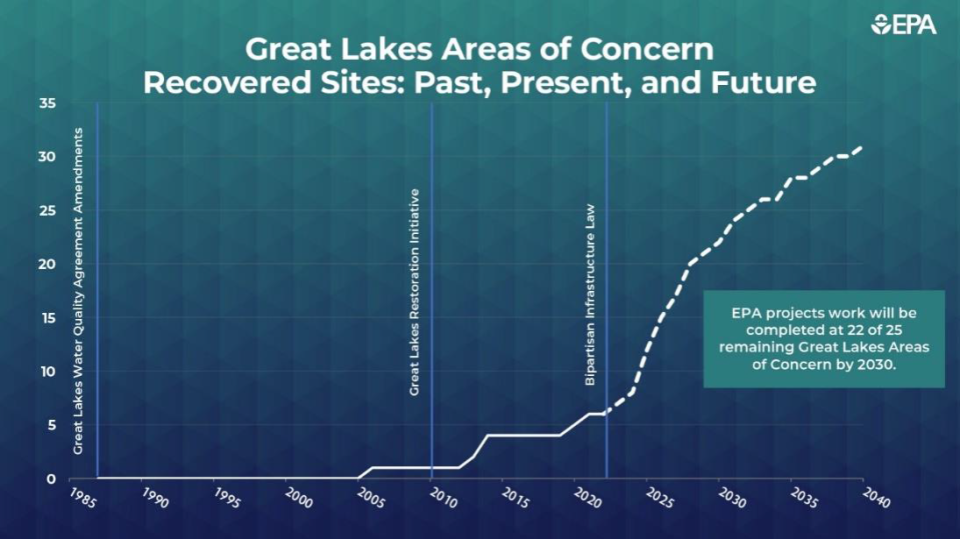President Biden, EPA $1 Billion Investment from the Bipartisan Infrastructure Law Will Accelerate Cleanup Efforts and Benefit Indiana
EPA Projects Work to Be Completed at 22 of 25 Remaining Great Lakes “Areas of Concern” by 2030
CHICAGO (Feb. 17, 2021) – Today, President Biden and U.S. Environmental Protection Agency Administrator Michael S. Regan will announce that as a direct result of the Bipartisan Infrastructure Law, EPA will make significant progress in the clean-up and restoration of the Great Lakes’ most environmentally degraded sites, securing clean water and a better environment for millions of Americans in the Great Lakes region. The agency will use the bulk of the $1 billion investment in the Great Lakes from the Bipartisan Infrastructure Law to clean up and restore severely degraded sites, known as “Areas of Concern” or AOCs. This will allow for a major acceleration of progress that will deliver significant environmental, economic, health, and recreational benefits for communities in Indiana and throughout the Great Lakes region.
“The Great Lakes are a vital economic engine and an irreplaceable environmental wonder, supplying drinking water for more than 40 million people, supporting more than 1.3 million jobs, and sustaining life for thousands of species. Through the investments from President Biden’s Bipartisan Infrastructure Law, we will make unprecedented progress in our efforts to restore and protect the waters and the communities of the Great Lakes basin,” said EPA Administrator Michael S. Regan. “Building a better America means investing in our natural resources and the communities they support.”
White House Senior Advisor and Infrastructure Implementation Coordinator Mitch Landrieu said, “With this investment, President Biden is delivering major environmental, public health, and economic wins for the Great Lakes region. Building a better America requires us to confront legacy pollution and clean up the environment – ensuring our kids drink clean water and creating good-paying jobs in the process. We know that cleaning up these waterways and improving the health of the Great Lakes will also create great economic opportunities for communities across the eight-state region and beyond.”
In 2018, an independent economic study from the Great Lakes Commission and the University of Michigan found that every Great Lakes Restoration Initiative dollar spent produces an additional $3.35 of economic activity. For older industrial cities, including AOCs such as Buffalo and Detroit, the study found that there may be more than $4 in additional economic activity for each federal dollar spent. A 2020 analysis of the Great Lakes determined that the region supports more than 1.3 million jobs, generating $82 billion in wages annually.
EPA projects that the Bipartisan Infrastructure Law funding, combined with funds from annual Great Lakes Restoration Initiative appropriations and funding from other sources, will, between now and the end of 2030, enable the Agency and its partners to bring work to completion across 22 of the 25 remaining AOCs, with Bipartisan Infrastructure Law funding directly supporting 11 of these sites. In sum this will leave only three of the original 31 U.S. AOCs with work remaining, with those sites also benefiting from Bipartisan Infrastructure Law funding. In the coming months, EPA will release more detailed information on implementation of the Bipartisan Infrastructure Law funding for the Great Lakes.
EPA expects work to be completed by 2030 in the Grand Calumet River, Indiana.
EPA will award this funding in accordance with the Biden Administration’s Justice40 Initiative, which promises to deliver at least 40 percent of the overall benefits from key federal investments to underserved communities. The effort also supports President Biden’s America the Beautiful initiative, which includes commitments to honor the nation’s conservation traditions, private property rights, the sovereignty of Tribal Nations, and the values and priorities of local communities.
In addition to support from the Bipartisan Infrastructure Law directed toward cleaning up the AOCs, EPA will continue the agency’s work to address other key issues such as addressing harmful algal blooms, nutrient reduction activities, protecting against invasive species, and monitoring the health of the Great Lakes. EPA anticipates additional resources could be available for these and other priorities because of the infusion of resources from the Bipartisan Infrastructure Law.
“I was proud to support the Infrastructure Investment and Jobs Act and am pleased to see this tangible result that will improve the environment and the economy of Northwest Indiana,” said Rep. Frank Mrvan. “Communities of color have had a disproportionately negative impact from the legacy costs of environmental pollution, and no individual should have to live near any environmental area of concern. The availability of these additional federal resources will further improve our region’s ability to create good-paying job opportunities and attract new businesses and residents. “
“This funding for the Great Lakes Restoration Initiative from the Bipartisan Infrastructure Law is crucial to continuing the clean-up efforts of the Grand Calumet River and Indiana Harbor Ship Canal,” said IDEM Commissioner Brian Rockensuess. “Restoring these contaminated waterways will benefit nearby communities through improvements to Indiana’s environment, economy, health, and recreation.”
“The U.S. EPA Great Lakes Restoration Initiative funds will definitely support the work required to improve water quality in the Grand Calumet River,” said Gary Mayor Jerome Prince. “The CARE workgroup is tasked with guiding the necessary work to delist the Grand Calumet River of impaired beneficial uses. These funds will get us closer to re-engaging recreational activities of this natural resource for all citizens to enjoy.”
To see the full list of Areas of Concerns and anticipated work completion and delisting dates please visit: https://www.epa.gov/great-lakes-aocs/list-great-lakes-aocs

